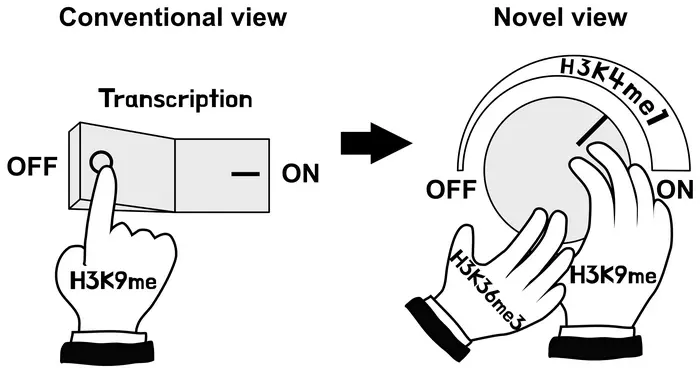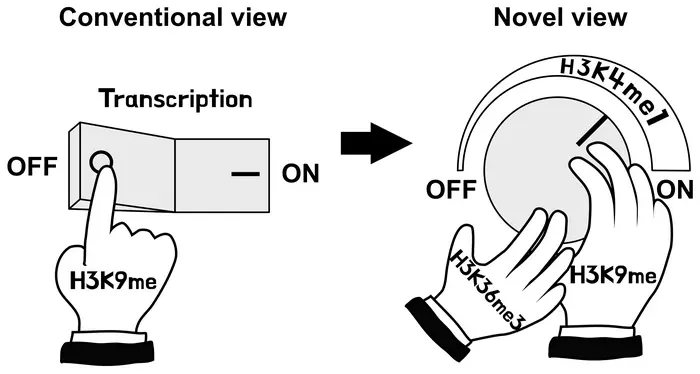Researchers led by Kannosuke Yabe, Asuka Kamio, and Soichi Inagaki of the University of Tokyo have discovered that in thale cresses histone H3 lysine-9 (H3K9) methylation, conventionally thought to be a mark of turning off gene transcription, can also turn on gene expression via the interactions of two other proteins and histone marks. The molecular mechanisms demonstrate that rather than functioning as a simple “off switch,” H3K9 methylation is more like a “dimmer switch” that fine-tunes DNA transcription. The discovery suggests there might be similar mechanisms in other organisms, too. The findings were published in the journal Science Advances.

Credit: Yabe et al 2024
Researchers led by Kannosuke Yabe, Asuka Kamio, and Soichi Inagaki of the University of Tokyo have discovered that in thale cresses histone H3 lysine-9 (H3K9) methylation, conventionally thought to be a mark of turning off gene transcription, can also turn on gene expression via the interactions of two other proteins and histone marks. The molecular mechanisms demonstrate that rather than functioning as a simple “off switch,” H3K9 methylation is more like a “dimmer switch” that fine-tunes DNA transcription. The discovery suggests there might be similar mechanisms in other organisms, too. The findings were published in the journal Science Advances.
DNA is often called the “blueprint of biological organisms.” However, calling it the “toolbox of cells” might be more accurate because cells also need to control which genes, the basic building blocks of DNA, are transcribed, or in other words, “turned on or off.” This is epigenetics, and it involves the complex interactions of many types of proteins, such as histones. H3K9 methylation is an epigenetic mark associated with turning off DNA transcription. Even though H3K9 methylation was discovered 25 years ago, not all of its molecular mechanisms have been clarified.
“Biological systems are so complex,” says Inagaki, the principal investigator, “that it is almost impossible for us to understand exactly how life works. But we can try to understand a tiny part of it. The regulation of gene activity is fundamental to life and is connected to a lot of biological phenomena.”
The researchers chose to investigate the molecular mechanisms of gene regulation in Arabidopsis thaliana, commonly known as thale cresses. The team used a technique called chromatin immunoprecipitation sequencing (ChIP-seq). This technique provides a detailed view of how proteins interact with DNA. It can be used to analyze the locations of protein modifications very precisely, making it a befitting tool to investigate histone methylation. Then, the results of H3K9 methylation’s peculiar role came in.
“At first, I did not pay attention to the results of the analysis,” Inagaki remembers, “and did not do any further research on the subject for about a year. I overlooked the finding because it was so unexpected. But one day I had a eureka moment and everything made sense in my head. After that, proving the hypothesis that H3K9 methylation had a dual role went smoothly.”
H3K9 methylation’s dual role is achieved via two other proteins, LDL2 and ASHH3. LDL2 helps to turn off genes by removing another histone mark, H3K4 methylation. ASHH3 turns the gene on by stopping LDL2 from working via a third histone mark, H3K36 methylation. The complex relationship of the 3 histone marks (H3K9, H3K4, H3K36) determines the gene’s activity.
“I’m happy that we discovered the fundamental aspect of gene regulation by H3K9 methylation, even though many studies around the function and controlling mechanisms of H3K9 methylation have been conducted in many organisms. I hope that this finding will stimulate further scientific endeavors to elucidate how gene regulation works,” Inagaki says, already thinking about future research.
Journal
Science Advances
DOI
10.1126/sciadv.adn4149
Method of Research
Data/statistical analysis
Subject of Research
Not applicable
Article Title
H3K9 methylation regulates heterochromatin silencing through incoherent feedforward loops
Article Publication Date
26-Jun-2024





